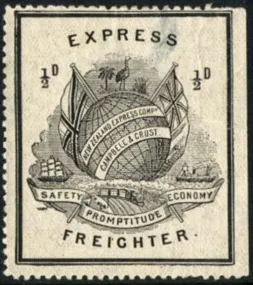
New Zealand Express was a company created to be an express forwarder of parcels, both throughout New Zealand and overseas. Set up in 1877 under the name Campbell and Crust, in 1895 it changed its name to New Zealand Express. The company seems to have had a good working relationship with New Zealand Railways which apparently included special drop boxes on certain trains, and parcel transfer arrangements.
This set of five value stamps appeared sometime in the last few years before the turn of the century. They were used in much the same way as similar NZ Railways revenue stamps, to show payment had been made on items being transported. The stamps ranged in value from ½d to 6d. Later another 1/- appeared in a different design and larger format.
The Design.
The stamp design shows the ambition of this company. Its goal is obviously to be a global 'Express Freighter,' with these words being prominently displayed along with the value. Notice the company motto "Safety Promptitude Economy." Just above this are two ships, one a sailing ship, on the left and the other a steam ship, on the right. In the centre just above the word 'Promptitude,' is the tiny train. Both the old company name and the new one are written across the globe.
The Stamps.
One Half Pence - ½d.
One Pence - 1d. (Two Colours)
Two Pence - 2d. Three Pence - 3d.
Six Pence - 6d.
One Shilling - 1/-
The One Shilling stamp was a different size and format and is believed to have appeared around 1930. This change might have been brought about by being unable to fit 1/- on to the smaller stamps. I am unsure as to why this higher demonization would be required other than an increase in charges for transporting parcels.
The one shilling is considered to be extremely rare since there is only one of these ever been found. This points to either the design was only used for a very short time period or that one shilling would have mostly been used on parcels going overseas.
Printing, Production and Scarcity.
Not much is known about the printing and production of these stamps. It seems likely that the denominations were removable slugs, as the position of the numeral and "d" shift about significantly on examples with the same denomination. This also points to the fact the same printing plate may have been used for more than one denomination which the value, paper and ink being changed between each print runs.
Scarcity - within this set the 1/2d and 1d are most often seen, the 2d and 3d less frequently, and the 6d is rare. The 1 Shilling can only be listed as extremely rare is only one copy is known to exist.
Scarcity - within this set the 1/2d and 1d are most often seen, the 2d and 3d less frequently, and the 6d is rare. The 1 Shilling can only be listed as extremely rare is only one copy is known to exist.






Mary Sullivan!
ReplyDeleteDid you used to own part of Anne's farm? Do you remember me? I worked at the petrol station in Wellsford. We live out near Port Albert. I married Paul, one of the Roberts boys, They live a couple of farms further down the valley from your old one.
We work for the same company Allan & Anne work for.
Kirsten
Yes dear, I remember you. The cheeky little red-head.
ReplyDeleteI remember Paul too. The middle boy. They used to come over and help with shearing and hay-making.
We brought another bigger farm which we ran until Ronny had an accident. Now its also owned by a corporate and our sons manage it.
Allan has given me you contact details so I'll be in touch soon.
Mary
We appreciate your engagement with our content. To ensure a respectful and constructive community, please take note of the following:
- No Spam, Please: We do not tolerate spammy or promotional comments. Any such comments will be promptly removed.
- Moderation in Place: All comments are moderated to maintain a positive and inclusive environment. Please be patient, as it may take a little time for your comment to appear.
- Sign In with Google: To comment, please sign in using your Google account. This helps us maintain the integrity of our community and allows for better interaction.